GCSE Tutoring Programme
Our chosen students improved 1.19 of a grade on average - 0.45 more than those who didn't have the tutoring.
In order to access this I need to be confident with:
Addition and subtraction
Multiplication and division
Types of quadrilaterals Simplifying algebraic expressions Squares and square roots Pythagoras’ theorem Decimal places BIDMASThis topic is relevant for:

Vectors
Here we will learn about vectors, including what vectors are and how to use vectors to solve geometry problems. We will also learn how to add, subtract and multiply them.
There are also vector worksheets based on Edexcel, AQA and OCR exam questions, along with further guidance on where to go next if you’re still stuck.
What are vectors?
Vectors describe a movement from one point to another. We need to be able to identify two characteristics of vectors, magnitude and direction. Magnitude is ‘how large’ something is.
We can find the magnitude of a vector by finding the length of the line segment. We can identify the direction of a vector from the direction of the arrow on line segment that represents it.
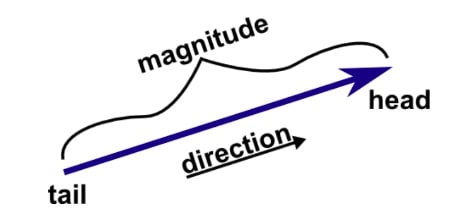
What is a vector?
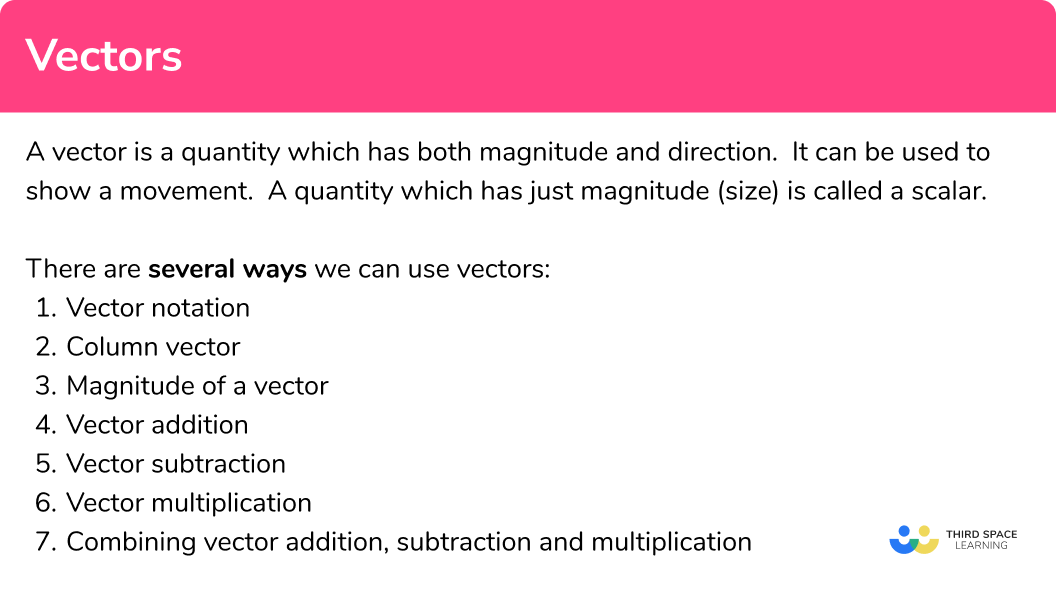
1. Vector notation
Vectors can be represented by a straight line segment with an arrow to show the direction of the vector (a directed line segment). These are also known as Euclidean vectors.
This diagram shows a vector representing the move from point A to point B.
In maths we use special notation to write the vector A to B. Boldface is often used in textbooks.
\overrightarrow{AB} =\textbf{a}=\underline{a}If we reverse the direction of the arrow, so that it is in the opposite direction, we get the negative of vector \textbf{a} .
Step-by-step guide: Vector notation
2. Column vector
We use column vectors to give information about a vector.
A vector has two components:
There is a horizontal component, also known as the x component. This is the top number in the column vector and tells us how many spaces to the right or left to move. If the number is positive, the direction is to the right. If the number is negative, the direction is to the left.
There is a vertical component, also known as the y component. This is the bottom number in the column vector and tells us how many spaces up or down to move. If the number is positive, the direction is upwards. If the number is negative, the direction is downwards.
E.g.
This tells us to go 5 to the right and 2 up.
-\textbf{a}= \begin{pmatrix} \; -5 \;\\ \; -2 \; \end{pmatrix}This tells us to go 5 to the left and 2 down.
Step-by-step guide: Column vector
3. Magnitude of a vector
We can find the magnitude of a vector (the length of the arrow). Notice that the vector components make a right-angled triangle. We can use vector components and Pythagoras’ theorem to find the magnitude of the vector.
The length of a vector is its absolute value and we use the modulus symbol.
Here is the formula:
\lvert \textbf{a} \rvert = \sqrt{x^2+y^2}E.g.
If the magnitude is equal to 1, then the vector is known as a unit vector.
If the magnitude is equal to 0 , then the vector is known as a zero vector.
Step-by-step guide: Magnitude of a vector
Vector arithmetic
4. Vector addition
Here is vector \textbf{a} and vector \textbf{b} .
We can add the vectors:
The vector \textbf{a} + \textbf{b} is known as the resultant vector.
Step-by-step guide: Vector addition
5. Vector subtraction
We can subtract vectors.
When subtracting vectors, the order is important.
Step-by-step guide: Vector subtraction
6. Vector multiplication
We can multiply vectors by a scalar.
E.g.
\textbf{a}= \begin{pmatrix} \; 5 \;\\ \; 2 \; \end{pmatrix} 2\textbf{a}= 2\begin{pmatrix} \; 5 \;\\ \; 2 \; \end{pmatrix} = \begin{pmatrix} \; 2 \times 5 \;\\ \; 2 \times 2 \; \end{pmatrix} = \begin{pmatrix} \; 10 \;\\ \; 4 \; \end{pmatrix}Step-by-step guide: Vector multiplication
7. Combining vector addition, subtraction and multiplication
Vector addition, subtraction and multiplication are often combined.
E.g.
3\textbf{a}-2\textbf{b}= 3\begin{pmatrix} \; 5 \;\\ \; 2 \; \end{pmatrix} -2 \begin{pmatrix} \; 3 \;\\ \; -1 \; \end{pmatrix} = \begin{pmatrix} \; 15 \;\\ \; 6 \; \end{pmatrix} - \begin{pmatrix} \; 6 \;\\ \; -2 \; \end{pmatrix} = \begin{pmatrix} \; 9 \;\\ \; 8 \; \end{pmatrix}A vector quantity you may meet in GCSE Science is velocity vector.
A scalar quantity would be speed.
Step-by-step guide: Vector problems
8. Vector geometry
We can solve geometrical problems using vectors. Vectors are equal if they have the same magnitude and direction regardless of where they are.
E.g.
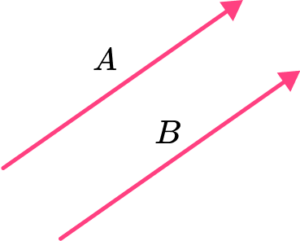
Vectors A and B are equal. They are travelling in the same direction and have the same magnitude (length).
E.g.
OBDE is a parallelogram. A is the midpoint of OE and C is the midpoint of BD.
OAFG is a parallelogram. C is the midpoint of AF and B is the midpoint of OG.
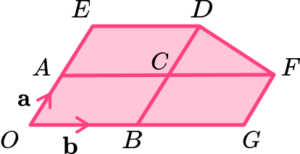
Vector \overrightarrow{ED}, \overrightarrow{AC} and \overrightarrow{OB} are equal. They are parallel, so they travel in the same directions. They also have the same magnitude.
Vectors \overrightarrow{OA}, \overrightarrow{BC}, \overrightarrow{AE}, \overrightarrow{CD} and \overrightarrow{GF} are also equal.
E.g.
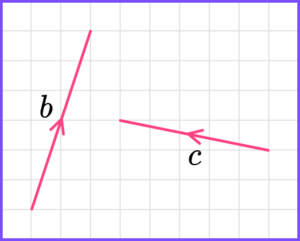
Vectors b and c are not equal. They do not have the same magnitude (length) and they do not travel in the same direction.
Negative vectors have the same magnitude but travel in the opposite direction.
E.g.
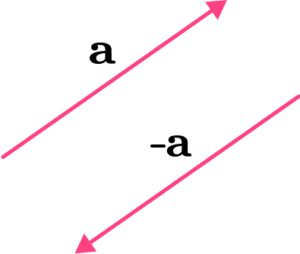
The vectors have the same magnitude but are travelling in the opposite direction, denoted by the arrows.
How to use vectors
In order to use vectors consider:
- If there is a diagram, read the information, add other vectors, check the route and simplify your answer if needed.
- Remember column vectors have two vector components.
- If you are asked to find the magnitude of a vector use Pythagoras’ theorem.
- If the question requires addition, subtracting and multiplying vectors – take care with the order of operations.
How to use vectors
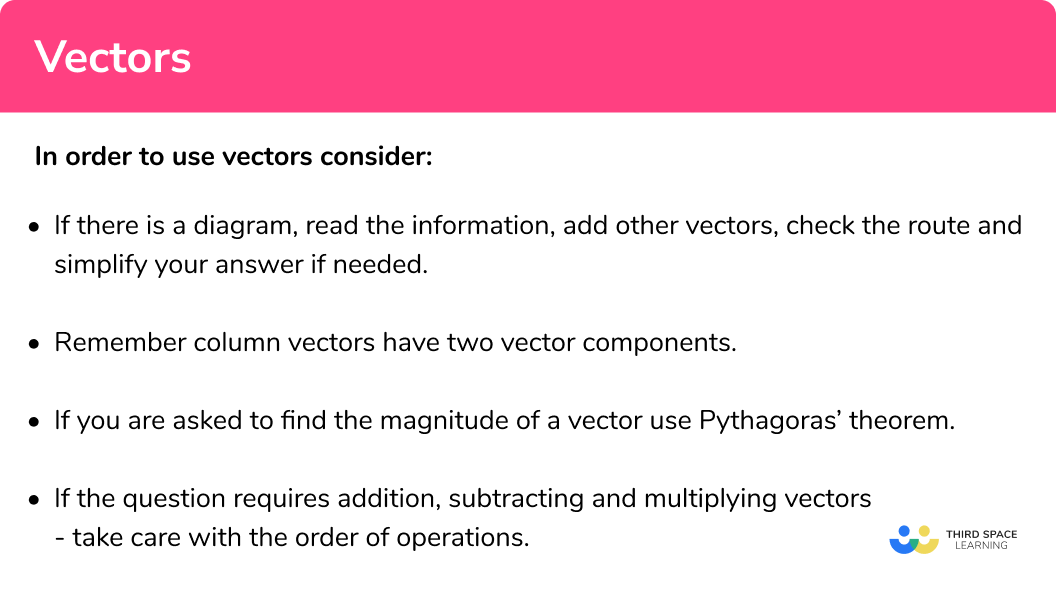

Vectors worksheet

Get your free vectors worksheet of 20+ questions and answers. Includes reasoning and applied questions.
DOWNLOAD FREE
Vectors worksheet

Get your free vectors worksheet of 20+ questions and answers. Includes reasoning and applied questions.
DOWNLOAD FREEVectors examples
Example 1: vector notation
Here is a parallelogram.
Write the vector \overrightarrow{CO} in terms of \textbf{a} and \textbf{b} .
- Use the information that the shape is a parallelogram to add in more vectors.
- Check the route – we need to start at point C and go to point O along the vectors.
Example 2: column vector
Write vector \textbf{v} as a column vector
- Vector \textbf{v} has two components, a horizontal component ( x component) and a vertical component ( y component).
- From the starting point at the bottom right point draw a horizontal line and a vertical line to make a right-angled triangle.
- We write the horizontal component first, here we have moved 3 to the left so we write this as -3 .
- Next we write the vertical component, here we have moved 4 upwards so we write this as 4 .
Example 3: magnitude of a vector
Calculate the magnitude of vector \textbf{c} , give your answer to 2 decimal places.
\textbf{c}= \begin{pmatrix} \; 5 \;\\ \; -3 \; \end{pmatrix}- We need to use Pythagoras’ theorem.
So the magnitude of vector \textbf{c} is 5.83 (to 2dp )
Example 4: vector addition
Here are two vectors, \textbf{a} and \textbf{b}
Work out \textbf{a}+\textbf{b}
- Add the x components and add the y components.
Example 5: vector subtraction
Here are two vectors \textbf{v} and \textbf{w}
Work out \textbf{w} - \textbf{v}
- Subtract the vector components. Make sure you get the vector subtraction in the correct order.
Example 6: vector multiplication
Here is the vector \textbf{f}
\textbf{f}= \begin{pmatrix} \; 4 \;\\ \; -3 \; \end{pmatrix}Work out 4
- Multiply both the vector components by the scalar (number)
Example 7: combining vector addition, subtraction and multiplication
Here are two vectors \textbf{c} and \textbf{d}
Work out 2\textbf{c}-4\textbf{d}
- Work out 2\textbf{c} and 4\textbf{d} separately and then subtract them.
- So, 2\textbf{c}-4\textbf{d} would be
- Or alternatively you can work them out in one line.
Common misconceptions
- Column vectors notation
2D column vectors only have 2 numbers within the brackets. Column vectors have the top number and the bottom number in the brackets.
There is no need for any other punctuation marks such as commas or semicolons. There is no need for a line to separate the numbers.
- Vector addition order
Vector addition is commutative. This means that the order in which we add vectors is not important.
\textbf{a}+\textbf{b}=\textbf{b}+\textbf{a}- Order of the subtraction
The order in which you subtract vectors is very important. It is NOT like vector addition where the order is unimportant. Vector subtraction is NOT commutative.
\textbf{a}-\textbf{b} \; \verb|≠| \; \textbf{b}-\textbf{a}- A component of a vector can be zero
Vector components can be zero.
E.g.
If both components of a vector are zero, this vector is known as the zero vector.
- Direction of the vector
Check the arrow on vector diagrams to see the direction of the vector. Check for negative signs in column vectors.
- Be careful calculating with negative numbers
It is easy to make errors with negative numbers when adding, subtracting, multiplying or squaring. Brackets around the negative number can make calculations more accurate.
E.g.
(-5)^2=25Practice vectors questions
1. Write the vector \overrightarrow{BC} in terms of \textbf{a} and \textbf{b}:




Go from point B to point C, via points A and D
\begin{aligned} \overrightarrow{BC}&=\overrightarrow{BA}+\overrightarrow{AD}+\overrightarrow{DC}\\\\ &=-7\textbf{b}+4\textbf{a}+5\textbf{b}\\\\ &=4\textbf{a}-2\textbf{b}\\\\ &\text{or in handwriting}\\\\ &=4\underline{a}-2\underline{b} \end{aligned}
2. Write this vector as a column vector:




We are aiming to draw a right-angled triangle with the starting point and the end point of the vector. Draw a horizontal line from the starting point. Because the line goes 2 squares to the left the top number of the column vector will be -2.
Then draw a vertical line to the end point. Because the line goes 3 squares upwards the bottom number of the column vector will be 3 .
\begin{pmatrix} \; -2 \;\\ \; 3 \; \end{pmatrix}
3. What is the magnitude of the following vector? Give your answer to 3 significant figures.
\begin{pmatrix} \; -4 \;\\ \; 7 \; \end{pmatrix}




The magnitude is calculated by using Pythagoras’ theorem.
\begin{aligned} \sqrt{x^2+y^2}&=\sqrt{(-4)^2+7^2}\\\\ &=\sqrt{65}\\\\ &=8.0622…\\\\ &=8.06 \ \text{to 3sf} \end{aligned}
4. Work out:
\begin{pmatrix} \; 5 \;\\ \; -1 \; \end{pmatrix} + \begin{pmatrix} \; -6 \;\\ \; 3 \; \end{pmatrix}




Add the x components and add the y components
\begin{pmatrix} \; 5 \;\\ \; -1 \; \end{pmatrix} + \begin{pmatrix} \; -6 \;\\ \; 3 \; \end{pmatrix} = \begin{pmatrix} \; 5+-6 \;\\ \; -1+3 \; \end{pmatrix} = \begin{pmatrix} \; -1 \;\\ \; 2 \; \end{pmatrix}
5. Work out:
\begin{pmatrix} \; 4 \;\\ \; -3 \; \end{pmatrix} – \begin{pmatrix} \; 5 \;\\ \; -6 \; \end{pmatrix}




6. Work out:
3\begin{pmatrix} \; 2 \;\\ \; -7 \; \end{pmatrix}




Each of the components are multiplied by the scalar number in front of the column vector.
3 \begin{pmatrix} \; 2 \;\\ \; -7 \; \end{pmatrix} = \begin{pmatrix} \; 3 \times 2 \;\\ \; 3 \times -7 \; \end{pmatrix} = \begin{pmatrix} \; 6 \;\\ \; -21 \; \end{pmatrix}
Vectors GCSE questions
1. The vector \textbf{c} is drawn on the grid.
(a) Write vector \textbf{c} as a column vector.
(b) From point P, draw the vector 3 \textbf{c} .
(2 marks)
(a)
\begin{pmatrix} \; 2 \;\\ \; -1 \; \end{pmatrix}
(1)
(b)
(1)
2. Here is trapezium
(a) Find, in terms of \textbf{a} , the vector \overrightarrow{AO} .
(b) Find, in terms of \textbf{a} and \textbf{b} , the vector \overrightarrow{OC} .
(c) Find, in terms of \textbf{a} and \textbf{b} , the vector \overrightarrow{AC} .
Give your answer in its simplest form.
(4 marks)
(a)
-9\textbf{a} \ \text{(or in handwriting: } -9\underline{a})
(1)
(b)
2\textbf{b}+6\textbf{a} \ \text{(or in handwriting: } 2\underline{b}+6\underline{a})
(1)
(c)
-9\textbf{b}+2\textbf{b}+6\textbf{a} \ \text{(or in handwriting: } -9\underline{a}+2\underline{b}+6\underline{a})
(1)
2\textbf{b}-3\textbf{a} \ \text{(or in handwriting: } 2\underline{b}-3\underline{a})
(1)
3. Here are two vectors
\textbf{a}= \begin{pmatrix} \; 4 \;\\ \; -1 \; \end{pmatrix}
\textbf{b}= \begin{pmatrix} \; 3 \;\\ \; 2 \; \end{pmatrix}
(a) Write down as a column vector, \textbf{a}+\textbf{b}
(b) Write down as a column vector, 3\textbf{a}+2\textbf{b}
(3 marks)
(a)
\begin{pmatrix} \; 7 \;\\ \; 1 \; \end{pmatrix}
(1)
(b)
3\textbf{a}=\begin{pmatrix} \; 12 \;\\ \; -3 \; \end{pmatrix}
2\textbf{b}= \begin{pmatrix} \; 6 \;\\ \; 4 \; \end{pmatrix}
(1)
\begin{pmatrix} \; 18 \;\\ \; 1 \; \end{pmatrix}
(1)
Learning checklist
You have now learned how to:
-
Write about vectors using vector notation
-
Write vectors as column vectors
-
Calculate the magnitude of a vector using Pythagoras’ theorem
-
Add vectors
-
Subtract vectors
-
Multiply a vector by a scalar
-
Solve geometry problems using vectors
The next lessons are
Did you know?
Vectors are very useful and can be extended beyond GCSE mathematics. Vector analysis is the branch of mathematics that studies vectors.
At GCSE we study two-dimensional vectors, but we can also look at three-dimensional vectors.
In A Level maths cartesian coordinates are also referred to as position vectors when we use a coordinate system as our vector space. In maths a vector is an element of a vector space.
Vectors can also be extended further by learning how to multiply two vectors together using the dot product. This is also known as the scalar product of two vectors. It is possible to multiply vectors another way is known as a cross product. This is also known as the vector product of two vectors.
Still stuck?
Prepare your KS4 students for maths GCSEs success with Third Space Learning. Weekly online one to one GCSE maths revision lessons delivered by expert maths tutors.

Find out more about our GCSE maths tuition programme.